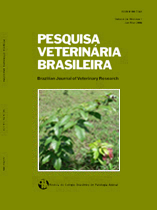 |
|
|
|
Year 2009 - Volume 29, Number 07
|

|
Animal infections by vaccinia-like virus in the state of Rio de Janeiro: An expanding disease, p.509-514
|
ABSTRACT.- Schatzmayr H.G., Simonetti B.R., Abreu D.C., Simonetti J.P., Simonetti S.R., Costa R.V.V., Gonçalves M.C.R., Gerhardt M.., Silva M.E.V., Farias-Filho J.C. & Barth O.M. 2009. Animal infections by vaccinia-like virus in the state of Rio de Janeiro: An expanding disease. Pesquisa Veterinária Brasileira 29(7):509-514. Laboratório de Morfologia e Morfogênese Viral, Instituto Oswaldo Cruz, Fiocruz, Avenida Brasil 4365, Rio de Janeiro, RJ 21040-900, Brazil. E-mail: hermann@ioc.fiocruz.br
In the present study we investigated the presence of infections by vaccinia-like viruses in dairy cattle from 12 counties in the state of Rio de Janeiro in the last 9 years. Clinical specimens were collected from adult animals with vesicular/pustular lesions mainly in the udder and teats, and from calves with lesions around the nose and mouth. A plaque reduction neutralization test (PRNT) was applied to search for antibodies to Orthopoxvirus; the vesicular/pustular fluids and scabs were examined by PCR, electron microscopy (EM) and by inoculation in VERO cells for virus isolation. Antibodies to Orthopoxvirus were detected in most cases. The PCR test indicated a high nucleotide homology among the isolates and the vaccinia viruses (VACV) used as controls. By EM, typical orthopoxvirus particles were observed in some specimens. The agents isolated in tissue culture were confirmed as vaccinia-like viruses by EM and PCR. The HA gene of the vaccinia-like Cantagalo/IOC virus isolated in our laboratory was sequenced and compared with other vaccinia-like isolates, showing high homology with the original Cantagalo strain, both strains isolated in 1999 from dairy cattle. Antibodies to Orthopoxvirus were detected in one wild rodent (genus Akodon sp.) collected in the northwestern region of the state, indicating the circulation of poxvirus in this area. Nonetheless, PCR applied to tissue samples collected from the wild rodents were negative. Vesicular/pustular lesions in people in close contact with animals have been also recorded. Thus, the vaccinia-like virus infections in cattle and humans in the state seem to be an expanding condition, resulting in economic losses to dairy herds and leading to transient incapacitating human disease. Therefore, a possible immunization of the dairy cattle in the state should be carefully evaluated. |
| |
|
|
| |
|
 |